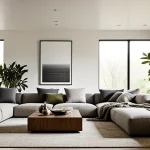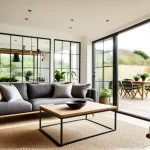Environmental Benefits of Sustainable Decor in UK Homes
Sustainable decor significantly reduces the environmental impact of UK housing by embracing practices that prioritise resourcefulness and care for the planet. One crucial approach involves reducing waste through upcycling and recycling. Items that might otherwise be discarded find new life as stylish or functional pieces, cutting down landfill contributions and consumption of virgin materials.
Another key benefit lies in lowering carbon footprints. Choosing decor crafted from locally-sourced or repurposed materials means fewer emissions from transportation and manufacturing. For instance, opting for British-made furniture or reclaimed wood supports regional producers while reducing fossil fuel dependence, aligning with the goals of UK housing sustainability.
Topic to read : How Does Home Décor Transform Your Living Space into a Sanctuary?
Additionally, sustainable decor helps in minimising pollution inside and outside the home by avoiding harmful chemicals often present in conventional finishes, paints, and adhesives. Eco-friendly homes benefit from natural or low-VOC (volatile organic compound) products, which lessen toxic emissions that contribute to air and soil pollution.
By focusing on these core areas, sustainable decor allows homeowners to create beautiful, functional spaces that actively support environmental stewardship within the UK context, demonstrating that style and responsibility can coexist seamlessly.
This might interest you : How Can You Transform Your Living Room into a Relaxing Sanctuary?
Health Advantages of Eco-Friendly Interior Choices
Choosing non-toxic materials in home decor significantly enhances indoor air quality, a critical aspect of healthy living environments. Non-toxic paints and natural textiles emit far fewer volatile organic compounds (VOCs) compared to conventional products, reducing harmful pollutants that can cause respiratory issues and allergic reactions. For readers wondering, “How do eco-friendly materials improve air quality?” the answer lies in eliminating these toxic chemical emissions, which otherwise linger in poorly ventilated rooms.
In addition, sustainable living incorporates cleaning products that minimize exposure to allergens and irritants. Many traditional cleaners contain harsh chemicals that exacerbate asthma and sensitivities. By switching to natural, biodegradable options, households decrease the risk of chronic irritation while supporting safer indoor environments.
Moreover, the use of natural elements and biophilic design—such as incorporating plants and natural light—can positively impact mental wellness. This approach not only brings a sense of calm and connection to nature but also improves mood and cognitive function. By embracing these health benefits, eco-friendly interiors create spaces that nurture both physical and psychological wellbeing, reinforcing the broader goals of sustainable living.
Economic Benefits and Cost Savings
Economic advantages are a compelling reason to embrace sustainable decor in UK homes. One major factor is cost savings stemming from improved energy efficiency. Installing energy-efficient lighting, insulation, and smart thermostats reduces utility bills by lowering electricity and heating demands. Over time, these savings accumulate, significantly offsetting initial investment costs.
Does investing in sustainable fixtures really save money long-term? Yes. Although the upfront price can be higher, energy-efficient upgrades depreciate slower and require less maintenance, offering a financially sound return on investment. For example, LED lighting consumes far less power than conventional bulbs, yielding measurable reductions in monthly electricity expenses.
Additionally, sustainable home improvements often boost property value. Buyers increasingly prioritise eco-friendly features due to rising awareness of environmental challenges and operational savings. Thus, incorporating sustainable upgrades positions properties competitively in the housing market.
Finally, many UK homeowners benefit from government grants and incentives that support eco-home improvements. These programs lower financial barriers and encourage adoption of sustainable technologies through rebates or tax relief, making sustainable investments even more accessible and rewarding.
Local Materials and UK Sustainability Standards
Supporting the use of local materials plays a vital role in advancing UK sustainability standards and reducing the environmental impact of home decor. By prioritising British manufacturing, homeowners not only help sustain regional craftsmanship but also cut down on transportation emissions, which contribute significantly to carbon footprints. Materials sourced locally often require less processing and shorter supply chains, aligning neatly with eco-friendly homes and the broader push for UK housing sustainability.
Navigating the UK’s complex landscape of eco regulations and certification schemes is essential for ensuring that materials and products meet recognised environmental benchmarks. Established eco-labels, such as the FSC (Forest Stewardship Council) for wood or other government-backed sustainable certification schemes, provide assurance about ethical sourcing and responsible production. This transparency aids consumers in making informed choices that support sustainable living goals effectively.
Adapting decor practices to the UK’s climate also exemplifies commitment to sustainability. Choosing season-appropriate, resource-conscious materials enhances durability and energy efficiency. For example, UK homes benefit from insulation and furnishings designed to retain warmth in winter and remain breathable during summer, reducing reliance on heating and cooling systems. This holistic approach reflects a deep understanding of how local environmental factors integrate with material choices, reinforcing eco-friendly homes’ positive contributions to both residents and the planet.
Trending Sustainable Decor Styles in the UK
Sustainable decor trends in the UK are evolving rapidly, reflecting growing consumer awareness and a collective push towards eco-friendly homes. Among the most popular styles is the upcycling of vintage or discarded items, which breathes new life into materials that might otherwise contribute to waste. This practice not only reduces environmental impact but also adds unique character to UK interiors.
The rise of zero-waste and minimalist decor aesthetics has taken hold as another defining trend. This approach focuses on simplicity and intentionality, encouraging homeowners to prioritise quality over quantity and avoid unnecessary consumption. Minimalism naturally aligns with sustainable living by minimising clutter and waste, creating spaces that are both beautiful and environmentally conscious.
Notably, several British brands and designers are at the forefront of championing sustainability. They incorporate innovative eco-conscious materials and methods into their work, demonstrating that ethical design is both stylish and practical. These pioneers inspire wider adoption of sustainable decor by proving that UK housing sustainability can be achieved without compromising on creativity or comfort.
Together, these trends highlight a dynamic movement towards greener homes that balance aesthetic appeal with environmental responsibility, making sustainable decor an accessible and desirable choice for UK households.
Practical Inspiration and Achievable Upgrades
Transforming your home with practical eco-friendly decor can be both simple and rewarding. Small, mindful changes contribute significantly to sustainability while enhancing everyday living. For instance, swapping traditional bulbs for LED lighting instantly lowers energy consumption with minimal effort. Similarly, installing smart thermostats optimises heating, trimming wasted energy without sacrificing comfort.
DIY sustainability projects allow homeowners to personalise upgrades while reducing waste. Upcycling existing furniture, repainting walls with eco-friendly paints, or crafting decorative items from recycled materials exemplify accessible ways to integrate sustainability. These efforts not only decrease reliance on new resources but also impart a distinctive, meaningful character to UK interiors.
For those seeking structured room makeovers, adopting step-by-step approaches ensures effectiveness. Begin by decluttering and assessing items that can be reused or refurbished. Next, incorporate energy-efficient fixtures alongside natural textiles and non-toxic finishes, enhancing both environmental and health benefits. This progression balances style with responsibility, demonstrating how achievable sustainable living can be.
Finally, sourcing ethical suppliers in the UK supports the entire sustainability cycle. Many local businesses specialise in eco-conscious products that meet UK standards, offering transparency and quality assurance. Relying on such suppliers reduces carbon footprints linked to transportation and promotes regional economies. By embracing these practical ideas, homeowners actively participate in the green home movement with confidence and impact.





